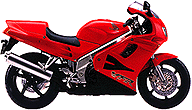

This interesting article was written by Martin Robiette who has graciously allowed me to place it here. The article was in response to a VFR Lister question regarding the amount of tire pressure in a cold tire when the temperatures reach more than 100 degrees (F)? It was very helpful to me and I expect to others.
Don't worry about going over the maximum recommended cold pressure when hot - that will always happen. As the tire flexes it will heat up and the pressure will rise. The lower the cold pressure, the more flex you will get, and the greater the rise in pressure. What you want to aim for is enough flex so the tire will heat up just enough to it's correct operating temperature but not so much it cooks itself. If you want to be really accurate you use a tire pyrometer to measure the temperature, but for real life (outside a race team), there's an easier rough method - see below.
A good rule of thumb to use (as we were told in our race school) when working out the correct tire pressure for maximum grip is that the pressure should rise 10% from cold to hot (take a gauge with you next ride and measure the hot pressure immediately after you stop). If it rises more than 10%, add air - if it rises less, reduce pressure. The cold pressure required will vary depending on the ambient conditions and how hard you are riding. This applies to both front and rear tires, and should result in the front being 1 or 2 pounds lower than the rear.
Of course when racing you can adjust for each track session, for general riding I would test a few conditions and come to a happy average. You may also want to vary the rule to optimise tire wear rather than grip - depends on your preferance and riding style.
In your case Ed (with a 13% rise), I would add a 1 or 2 pounds cold pressure when it is really hot outside - the tire is closer to its optimum temperature already. Don't forget to drop them when it cools down though! I have to confess I havn't done this test on my VFR, but I've found 34F/36R seems to work pretty good under normal WA temps (ie nowhere near what you are getting in Texas!).
Hope this helps,
Martin
'96 VFR
Seattle
